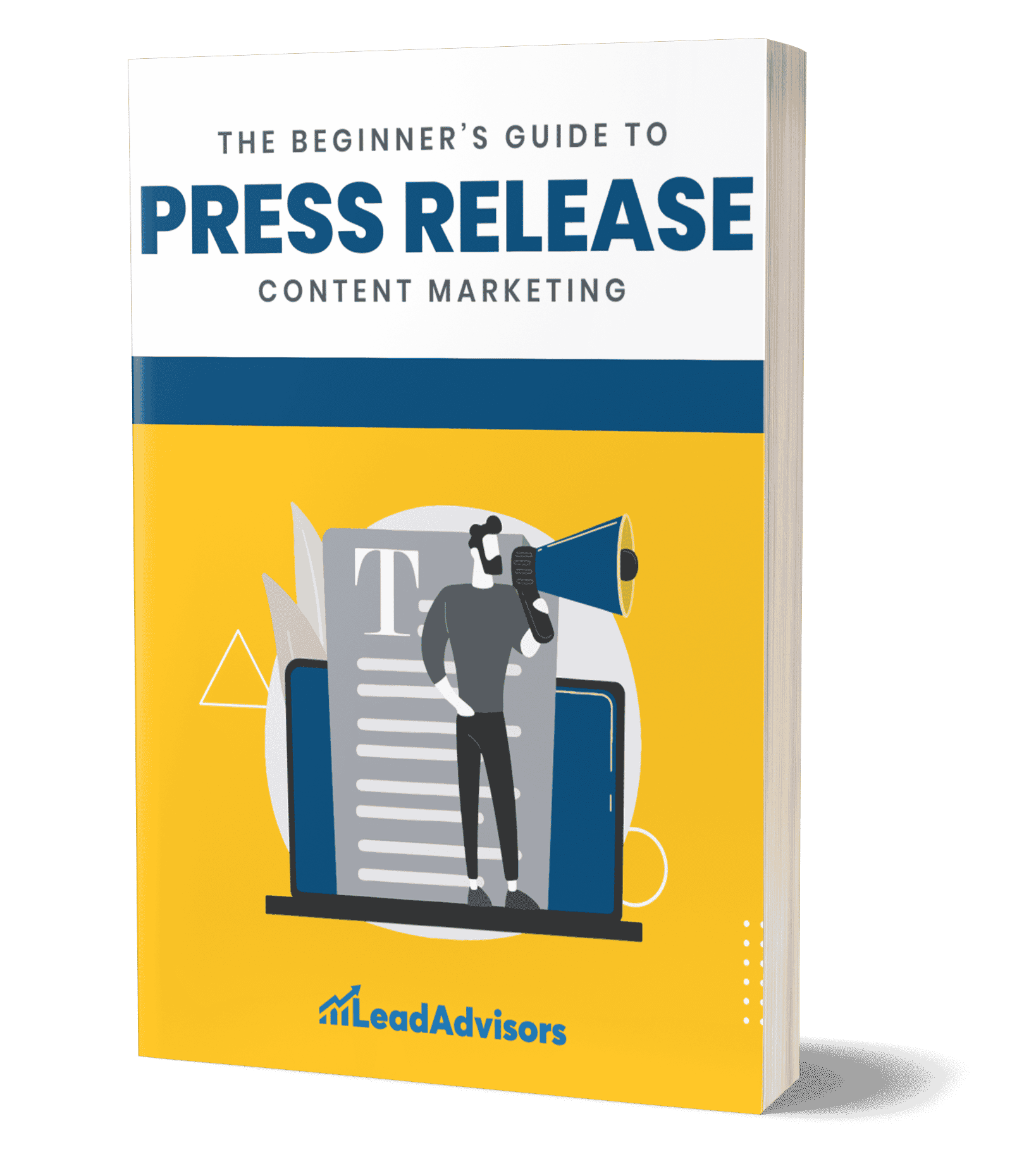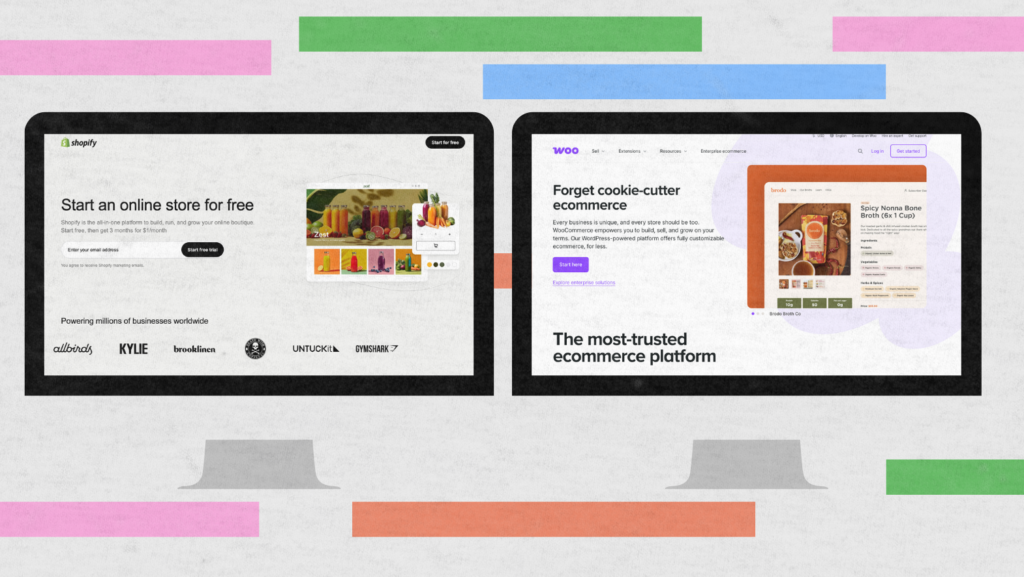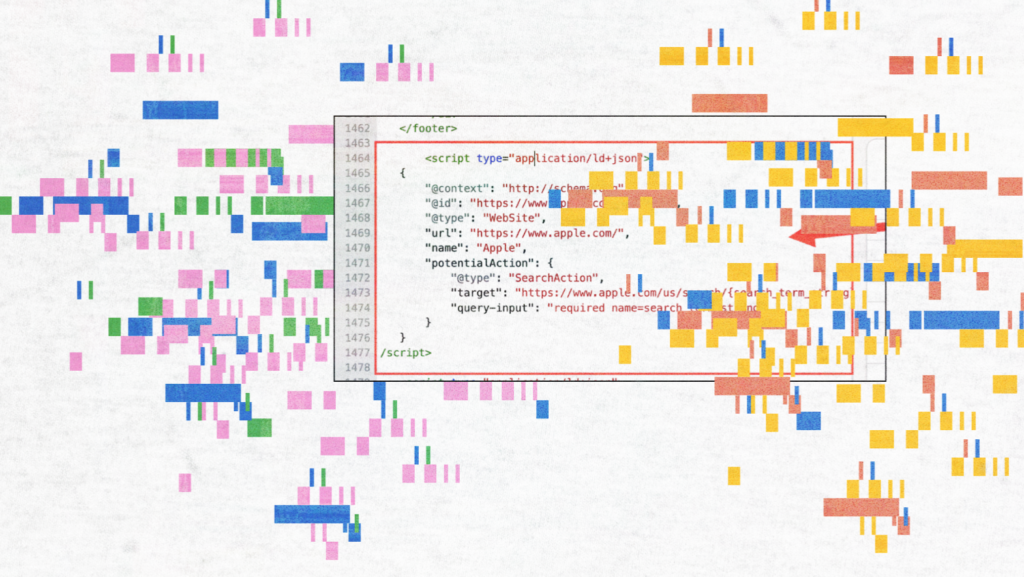Today, in 2025, a solid performance review template is all the more crucial.
The traditional performance review has changed from an annual achievement rating to a strategic tool for enhancing employee performance and engagement and directing an organization toward common goals. But done without some kind of transparent file system, it will come across as lumpy, rushed, or, god forbid, pointless.
This is where a fantastic review template can be truly beneficial. It makes things clear and lets the victim not only level the playing field but also be more “part of” the evaluation process, less of a meat puppet to be evaluated at.
In this post, I will tell you where to find the best resources for performance reviews, give you real examples, and give you six really great tips to help you get everything you can out of them. You’ll even see free downloads (hello, Google Docs!) to make writing your next review as easy and effective as possible.
So let’s get after it and make performance reviews work for you, not you for them.
What Is a Performance Review Template?
A performance review template is like a cheat sheet for helping you conduct a more efficient performance review.
It’s a formal document – digital or printed – that is referred to during conversations about performance reviews. Whether you’re a manager assessing your staff, an HR professional writing quarterly reviews, or an employee completing your self-appraisal, there’s a template that will make the review process fast and easy.
I’ve manipulated templates of all kinds – Word, Excel, Google Docs, even a digital platform with a complete workflow. Whatever the tool, the goal is the same: to make the process of performance reviews easier for everyone involved.
Here’s why I swear by them:
- They save time. No need to reinvent the wheel for every review period.
- They encourage fairness. Everyone is measured using the same criteria, making it easier to avoid bias.
- They standardize evaluations. Whether it’s quarterly performance reviews or the yearly review, having templates makes sure everyone is on the same page around expectations.
- They improve the quality of feedback. It’s much easier to share constructive feedback and call out wins when you have a structure to follow.
Long story short? Templates remove the guessing from evaluations – and that’s what we need when we’re busy.
Essential Components of an Effective Review Template
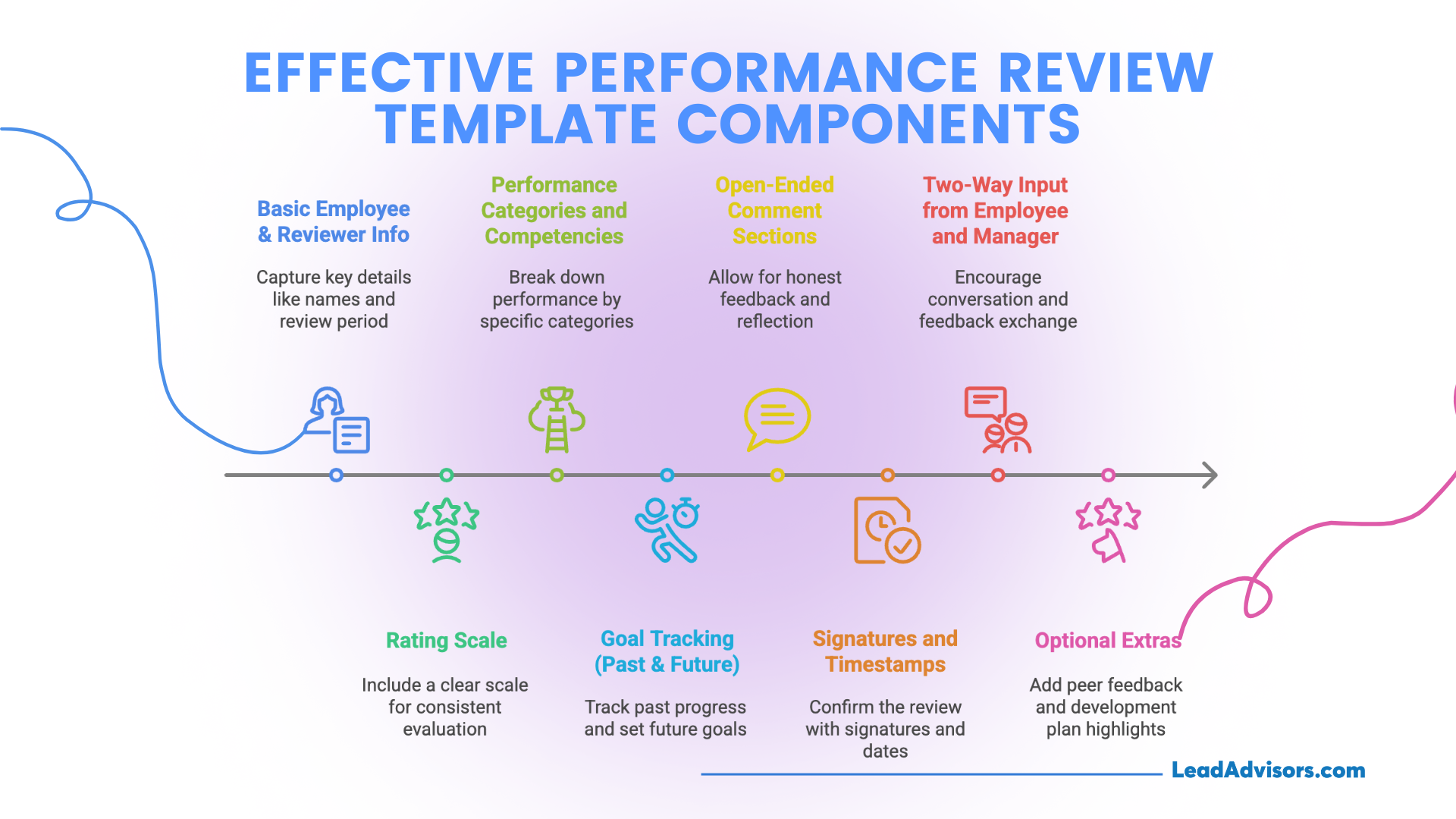
So you’ve decided to use a performance review template – great move. But let’s talk about what actually makes one effective. A random checklist won’t cut it. You need something that supports clarity, growth, and open communication during the employee review process.
Here’s a closer look at the must-have elements I always recommend including:
Basic Employee & Reviewer Info
Start simple. A great employee review form should also include employee details such as the employee’s name, role, department, reviewer’s name, and review period (whether it’s a mid-year performance review or an annual performance review). This is perhaps obvious, but without this info, things can go off the rails pretty quickly, especially when tracking an employee’s long-term progress.
Rating Scale
Ever try to compare feedback without a proper rating system? It’s chaos. Your review template should include a clear scale – whether that’s a 1–5 numerical scale, semantic labels like “Exceeds Expectations,” or the classic Likert scale. The point is consistency.
A structured performance rating system makes it easier to evaluate the employee’s performance objectively across different reviewers or teams.
Performance Categories and Competencies
This is where the real magic is. Break down performance by specific categories like:
- Communication
- Team collaboration
- Leadership skills
- Job knowledge
- Meeting deadlines
- Problem-solving
Use this section to contemplate how employees fulfill their job descriptions. You may even want to align those categories to your organization’s core values or business goals to make the performance evaluation resonate more with the employee.
Goal Tracking (Past & Future)
Good reviews look backward and forward. Include space to track past performance, measure progress on previous employee goals, and set fresh, measurable goals for the next period. Whether it’s working on a skill, new projects, or a sales target, writing these down helps you and your employees with development and accountability.
Pro tip: I also add sections for career and personal goals to encourage more balanced professional development.
Open-Ended Comment Sections
White space is powerful. Open-ended questions, manager comments, and self-assessment responses provide enough space to leave honest, anonymous feedback. Employees get to review themselves, and their manager gets to critique with tangible examples that help produce genuine growth.
Signatures and Timestamps
Every effective performance review form needs a sign-off section. It keeps things professional and shows that the conversation actually took place. This is useful for HR departments to monitor reviews and minimize friction if there are any questions later in the employee review process.
Two-Way Input from Employee and Manager
The fact is, the reviews with the most clout are not lectures but conversations. Ensure that your performance review form includes room for student feedback and the manager’s action plans. Giving employees a voice builds trust and establishes a practice of regular feedback in the future.
Optional (But Awesome) Extras
Want to level up your review game? Add sections for:
- Peer feedback or peer review summaries
- Notes on training, mentorship, or coaching received
- Alignment with core values
- Highlights from employee development plans
These additional insights provide a fuller picture of the employee’s performance, and they can be particularly useful when examining new team members or when preparing for annual reviews.
At the end of the day, your template is a means to help you think (and not cover every possible base). When it’s done right, a performance review template is more than a bunch of meaningless numbers – it’s a reflection of personal growth.
Best Practices for Using Performance Review Templates
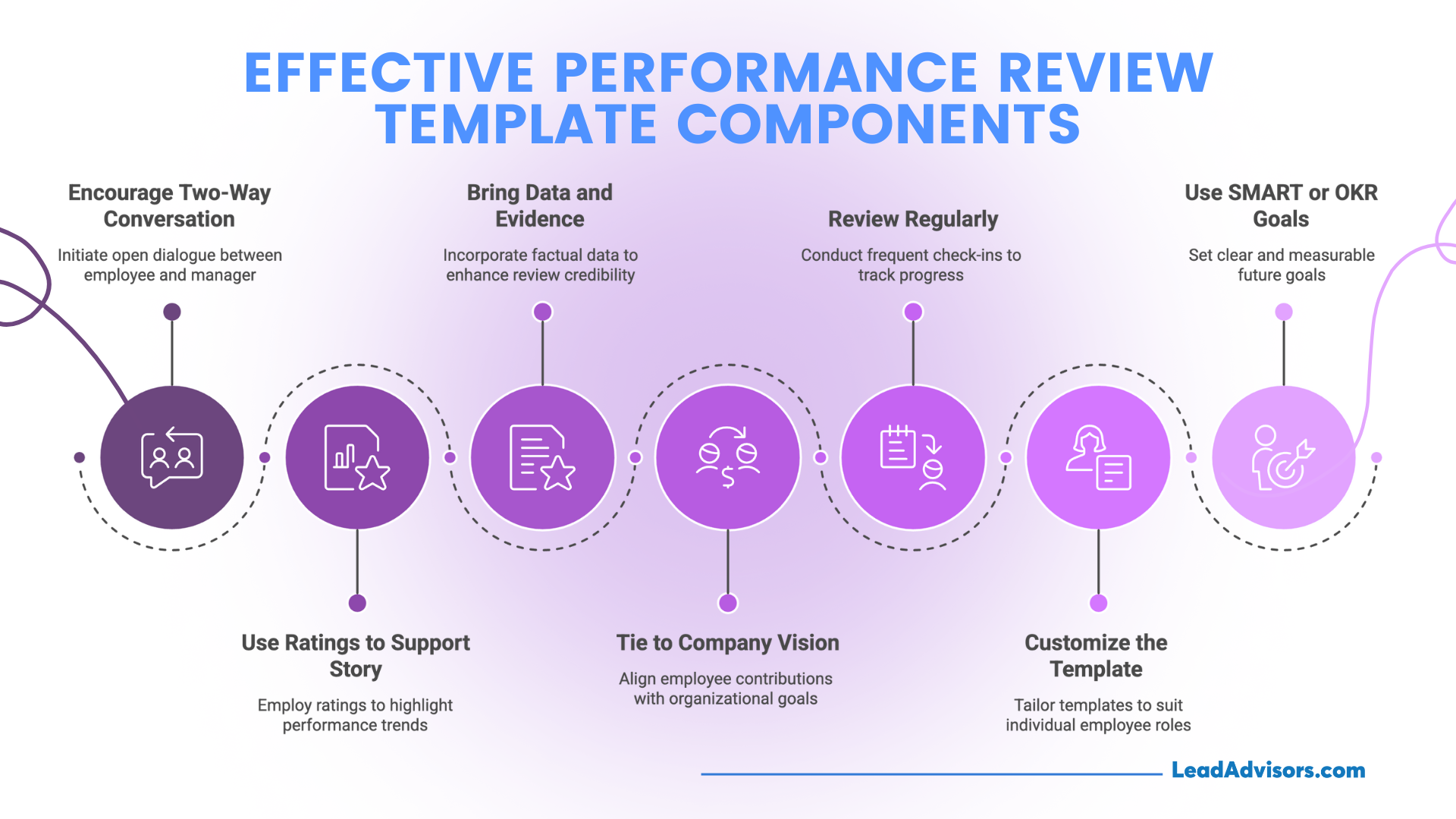
A performance review template is only helpful if it’s used properly. Even the most polished layout and logically organized structure won’t work if the process sounds hurried, uneven, or murky.
Here’s a guide to what I think of as “Do This, Not That” in every performance review:
Do: Encourage a Two-Way Conversation
Don’t: Treat it like a one-way critique
The best performance reviews feel like thoughtful exchanges. I always send the employee evaluation form beforehand so the employee has space for self-assessment and reflection. This opens the door for valuable employee feedback and builds trust between both sides.
Do: Use Ratings to Support the Story
Don’t: Let numbers replace the conversation.
Yes, a rating system or numerical scale keeps things standardized, but don’t stop there. I use ratings to identify trends, then guide the discussion with constructive feedback and specific examples that help the employees reflect on their own performance and growth areas.
Do: Bring Data and Evidence
Don’t: Base everything on gut feelings.
Solid reviews rely on facts. Referencing past performance, outcomes, or employee goals adds credibility. Sometimes I’ll even include peer feedback or insights from collaborative projects. This keeps the performance evaluation objective and helpful.
Do: Tie It to Company Vision
Don’t: Focus only on the individual.
A strong performance review process shows how the employee’s contributions align with your company’s organizational goals and core values – just like a growth marketing approach ties tactics to long-term strategic scaling.
Do: Review Regularly
Don’t: Wait until the end of the year.
Depending solely on annual performance reviews is stressful and surprising. Instead, I incorporate mid-year reviews or informal check-ins to ensure feedback doesn’t wane. Then we can track employee progress and make needed adjustments throughout the year.
Do: Customize the Template
Don’t: Use the same one for everyone.
Not every employee needs the same approach. A new employee just out of onboarding will need different prompts than a team lead managing direct reports. Adapt your performance review template by role, seniority, and role scope.
Do: Use SMART or OKR Goals
Don’t: Leave future goals vague.
Cookie-cutter goals will not move the needle. I suggest relying on frameworks like SMART or OKR to define future goals and ensure they are specific, measurable, and motivating. That means there’s no question about progress when it comes to the next review period.
When you implement some of these best practices, your performance review form becomes more than a perfunctory process – it becomes a means to clarity, growth, and more manageable employee development in the long run.
Types of Performance Review Templates (With Use Cases + Pros/Cons)
Not all performance review templates are created equal – and honestly, they shouldn’t be. Different teams, roles, and goals call for different formats. Over the years, I have tested a lot of templates, and I can tell you: the best one depends on what you’re trying to do.
Here’s an overview of the most useful kinds of templates, when to use them, and what to expect from each.
A. General & Annual Review Templates
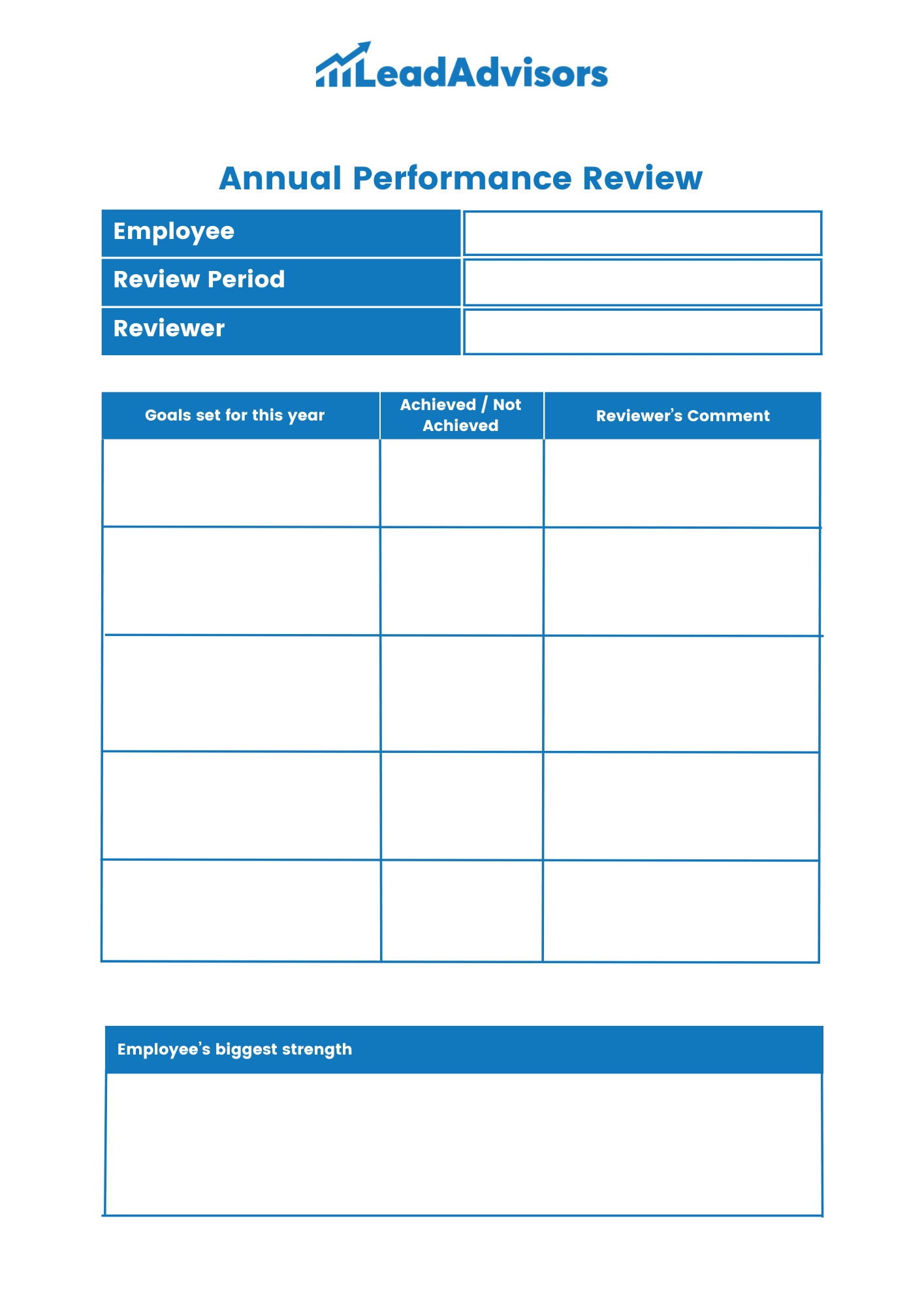
These are your classic, full-scope templates. They’re designed for an annual performance review template and cover the whole year’s highlights, challenges, and employee performance review metrics.
- Structure: Holistic performance across competencies, goals, and behaviors
- Best for: Tenured employees or more traditional annual reviews
- Pros: Shows the big picture of historical performance
- Formats: Word, Excel, Google Docs template
If you’re doing performance appraisals annually, this one’s your go-to.
B. Quarterly & Monthly Check-In Templates
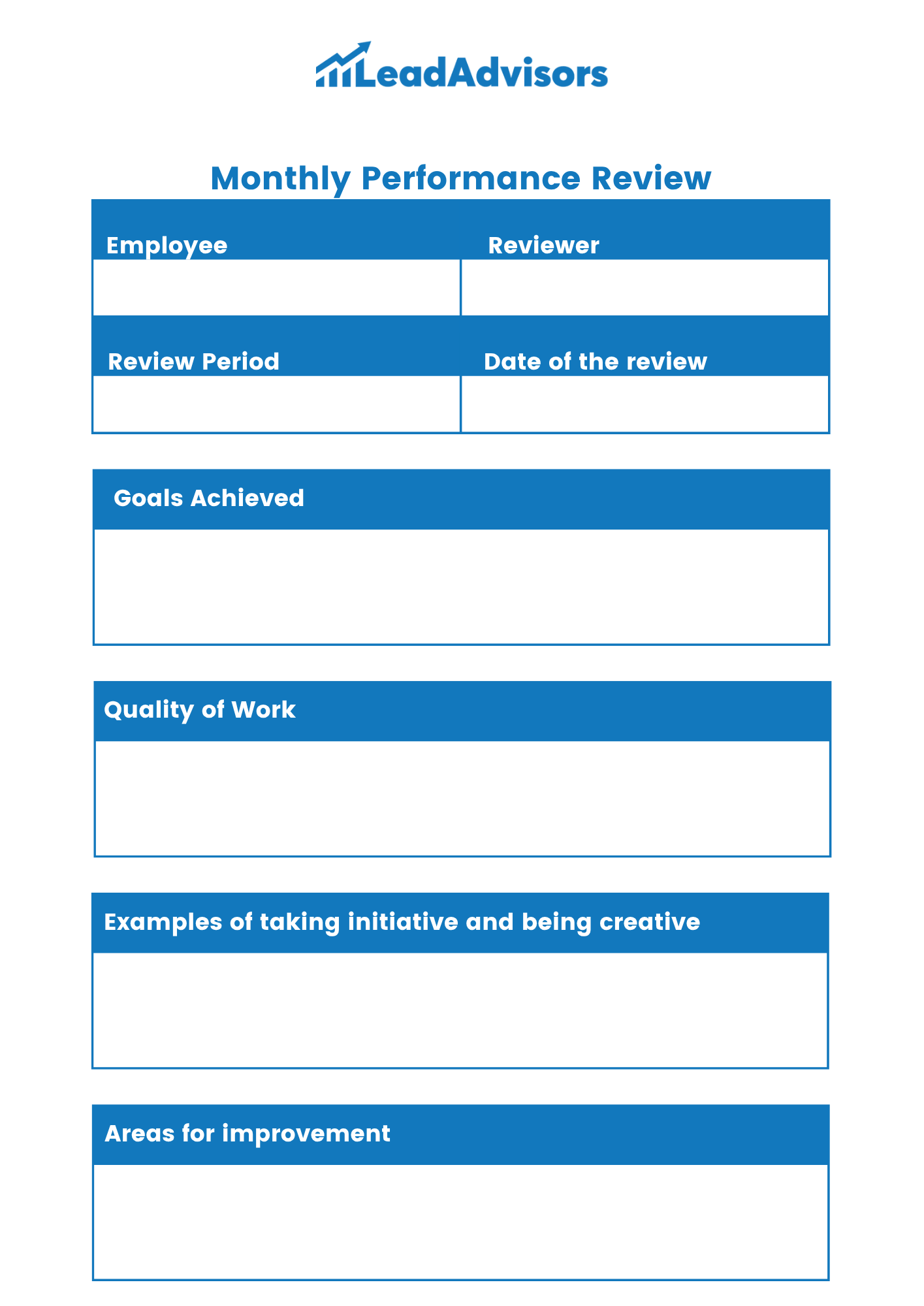
For more rapid contexts, I suggest shorter, more frequent reviews. These check-ins make goals and feedback a more pressing priority for all.
- Structure: Short-term goals should be met, and quick wins accomplished.
- Best for: Agile teams, startups, or new team members
- Pros: Encourages frequent feedback and fast course correction
I use these when a team grows fast and needs to stay aligned.
C. Mid-Year Performance Reviews
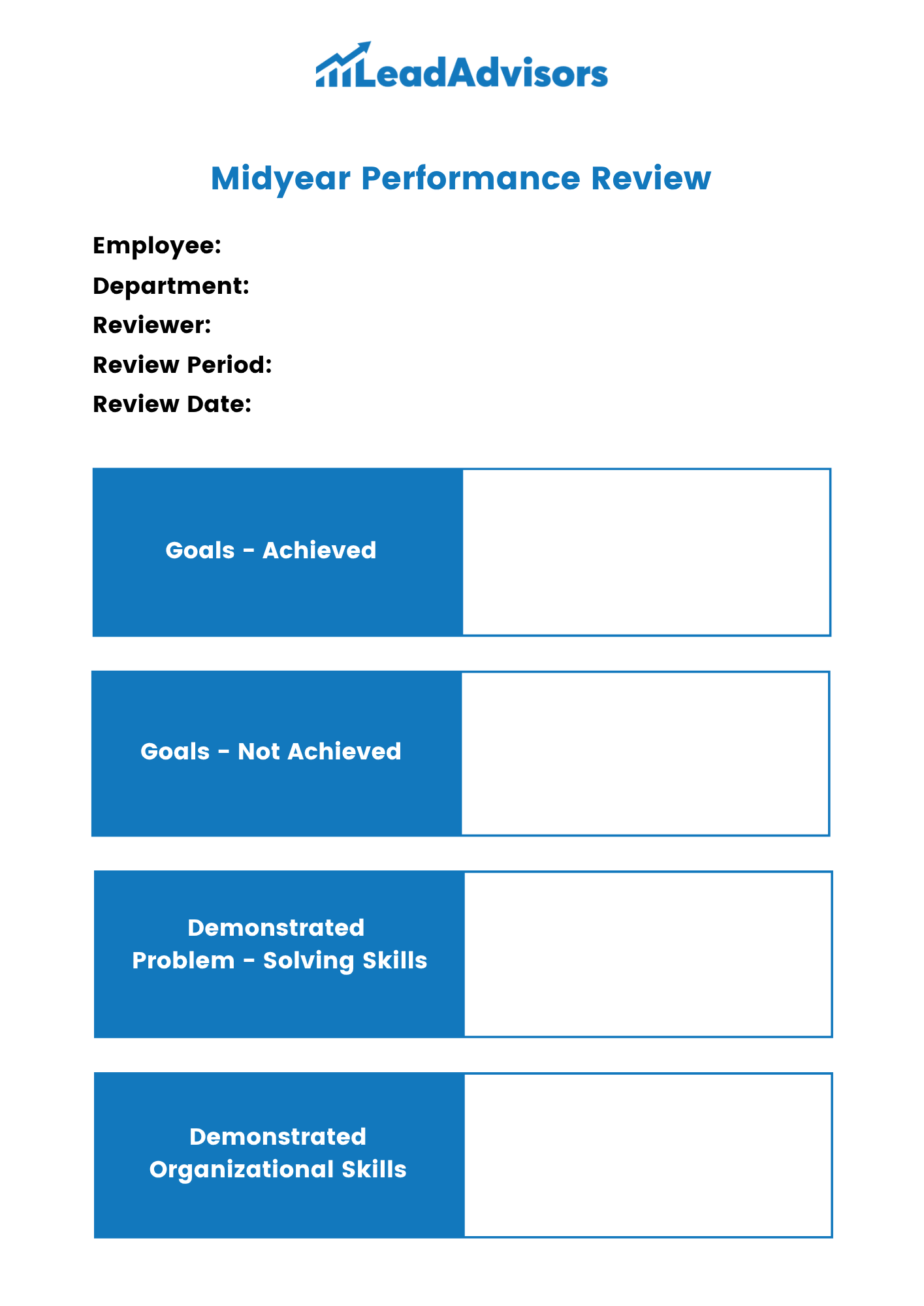
This is your halfway point check-in. I like to consider this the “how are we doing? chat that keeps long-term goals on track.
- Use: Reflect, reassess, and realign on priorities.
- Includes: Achievements, blockers, and necessary adjustments
- Best for: Companies that do biannual performance reviews
Perfect for catching issues early or updating your employee development plan.
D. Self-Evaluation Templates
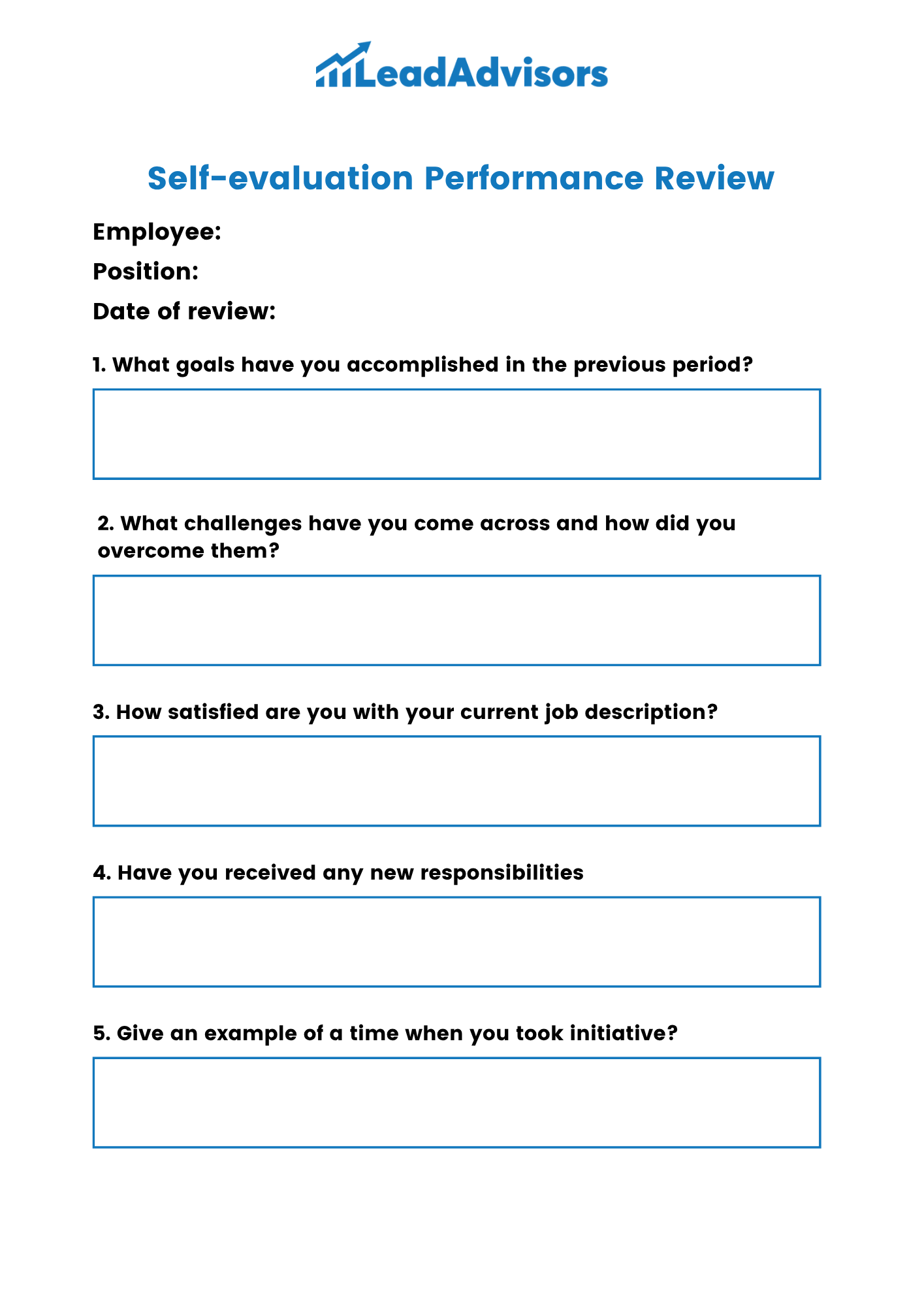
These templates give employees the chance to reflect on their performance. I love using these as pre-work before manager reviews.
- Purpose: Boost accountability and ownership
- Use with: Manager evaluations or 360-degree feedback.
- Pros: Builds employee engagement and fairness
When employees take time to assess themselves, the entire employee review process becomes richer.
E. Peer Review Templates
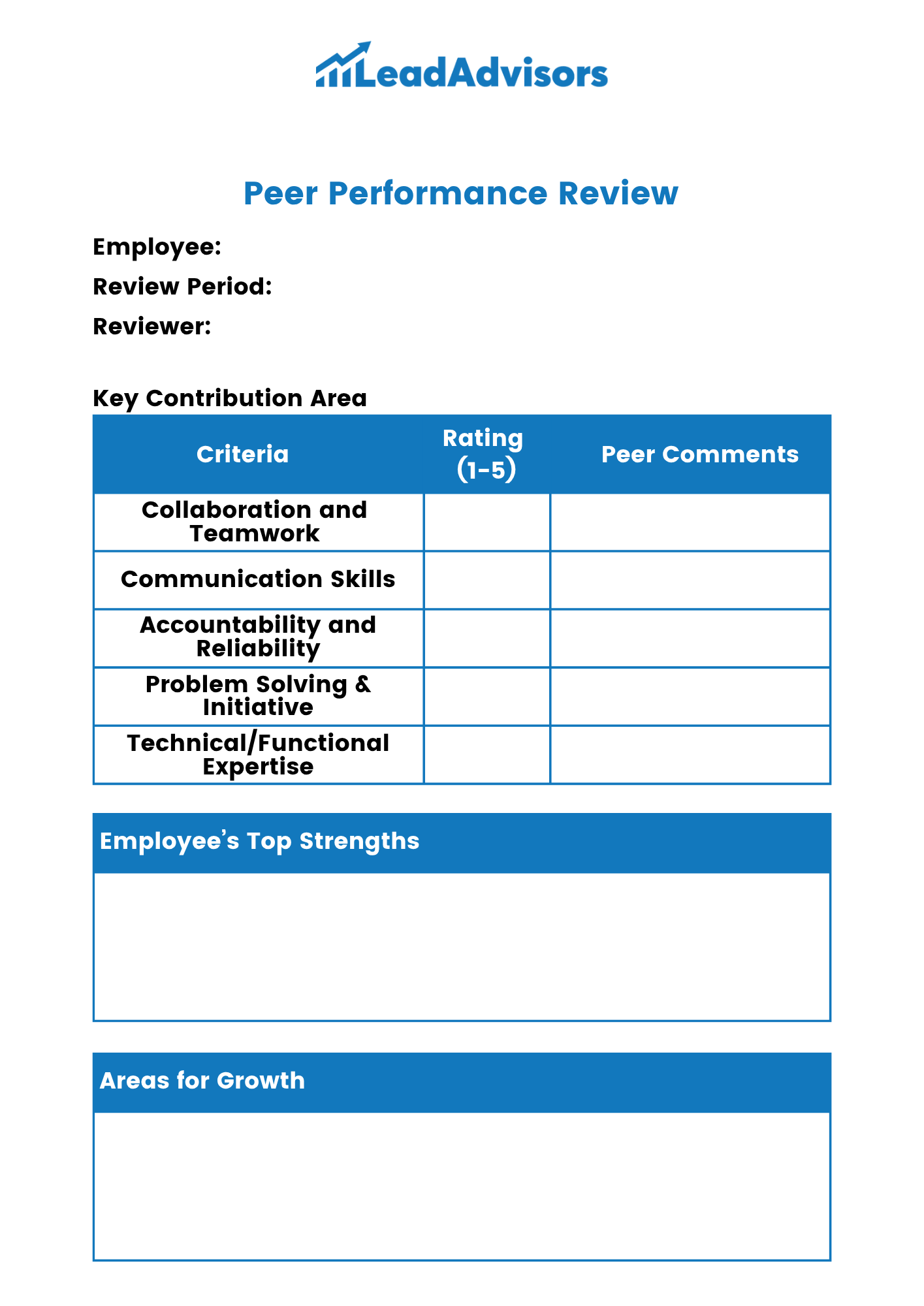
Peer feedback matters – especially in collaborative teams. These templates enable coworkers to vote (often anonymously) on someone’s performance.
- Structure: Comments, suggestions, or criticisms made by peers
- Best for: Cross-functional and agile teams
- Pros: Brings in new perspectives and reinforces team collaboration
Helpful when employee progress isn’t always visible to a direct manager.
F. 360-Degree Review Templates
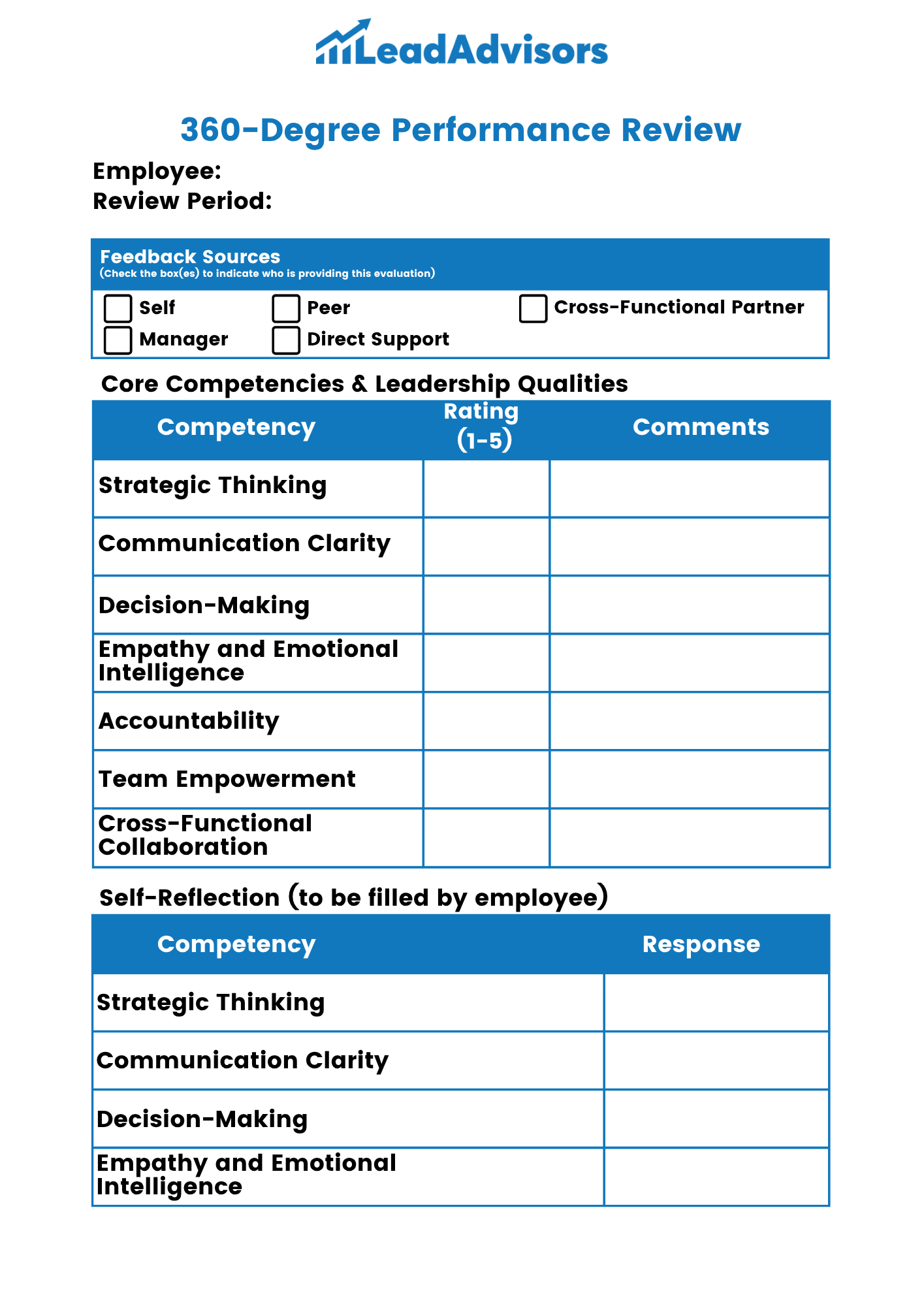
This is the ultimate all-around view – managers, peers, direct reports, and even self-reflections all rolled into one.
- Purpose: Holistic evaluation from multiple viewpoints
- Best for: Leadership roles, matrix teams, or org-wide reviews
- Pros: Well-rounded and more objective
If you’re evaluating leadership skills or complex roles, this is a great choice.
G. 30-60-90 Day Plans
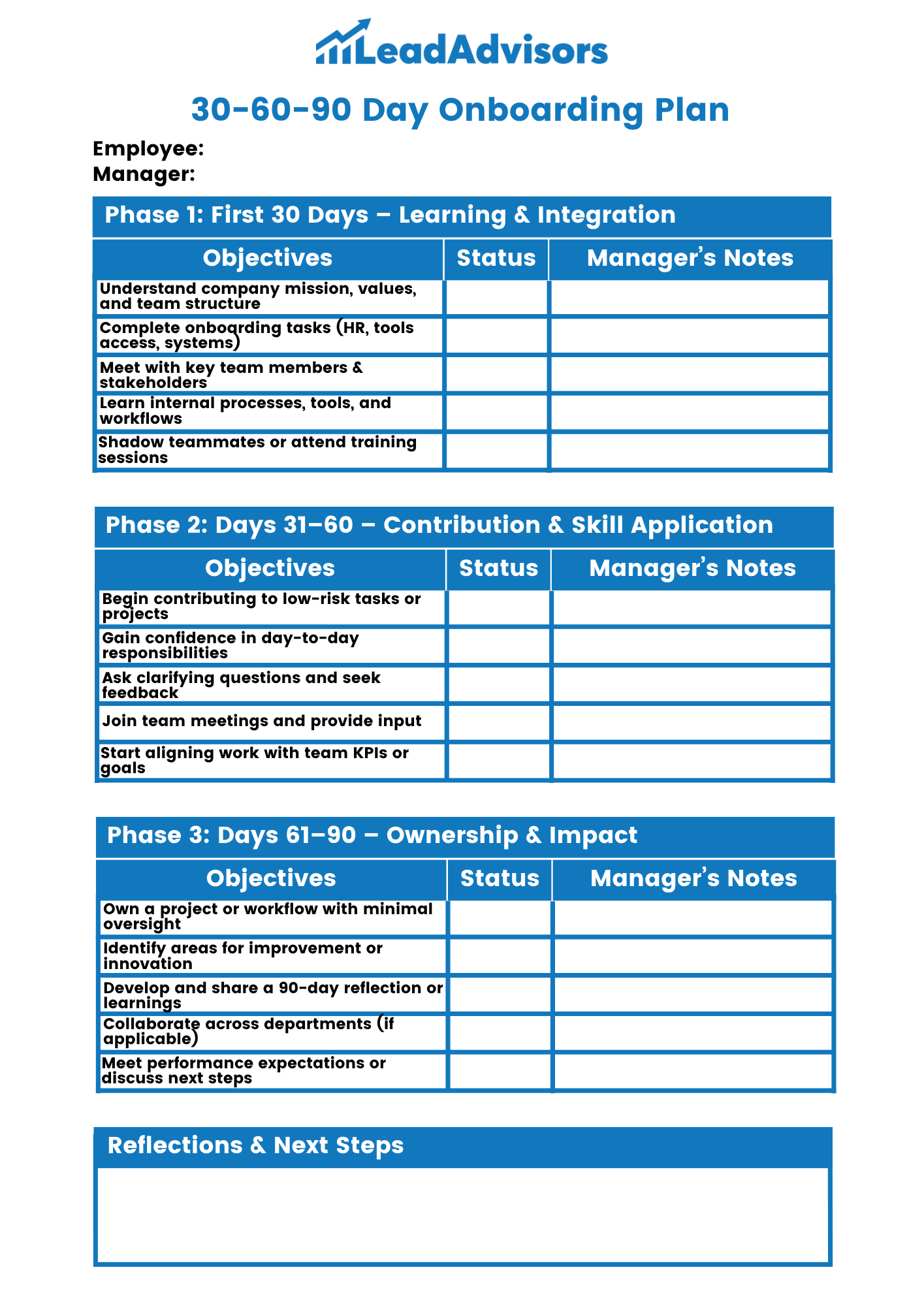
Great for onboarding, these templates track the employee’s goals and learning during their first few months.
- Structure: Milestone-based goals for new hires
- Best for: Onboarding new employees
- Pros: Builds structure, accountability, and role expectations from day one
Helps managers support employee development right from the start.
H. 90-Day Review Templates
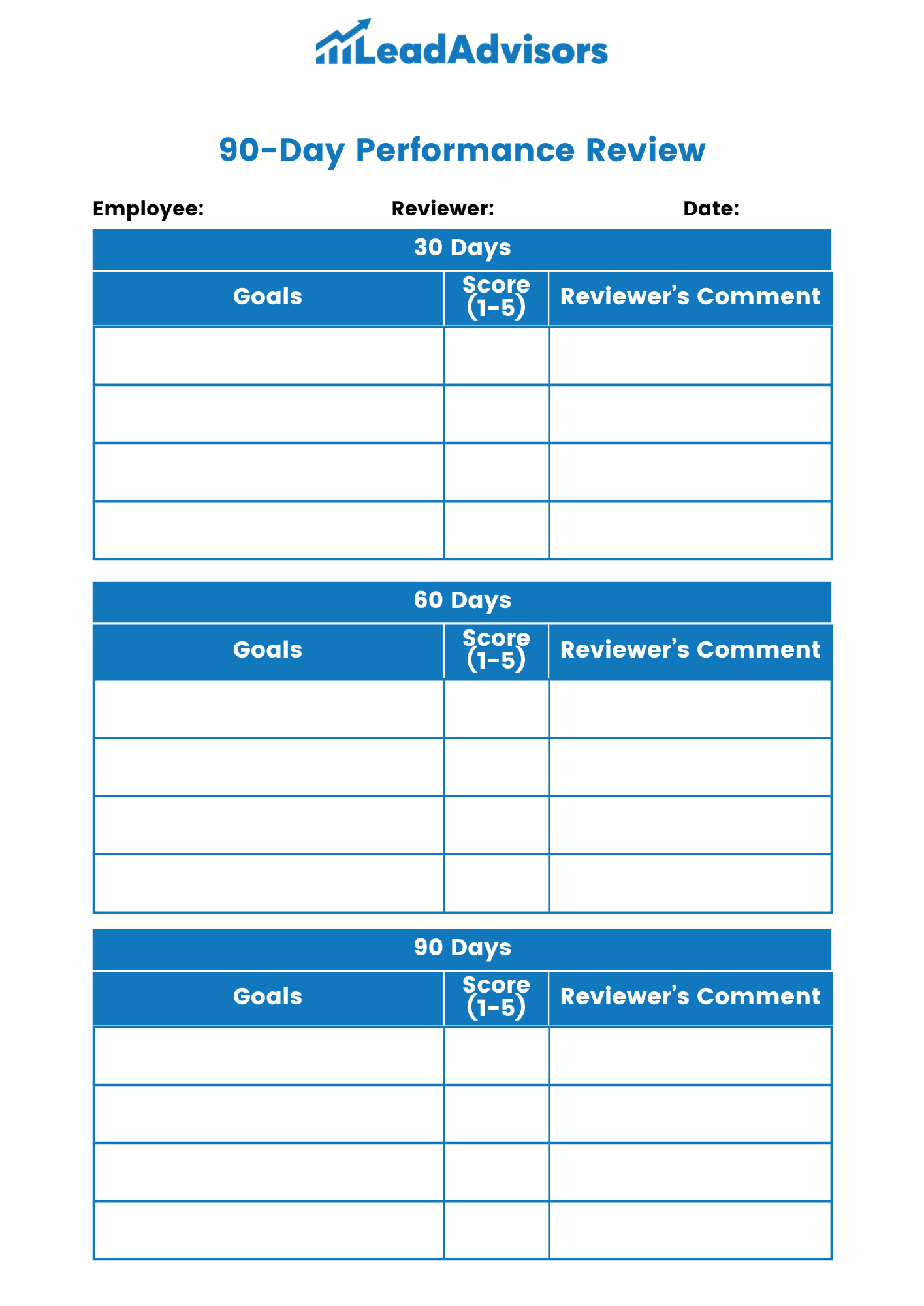
Once onboarding wraps, this template helps assess job fit and early results.
- Focus: Performance in early months, learning curve, and next steps
- Includes: Progress on measurable goals, training needs
- Pros: Offers early actionable feedback and development guidance
I use this one to support growth before a performance improvement plan is even needed.
I. Performance Improvement Plan (PIP) Templates
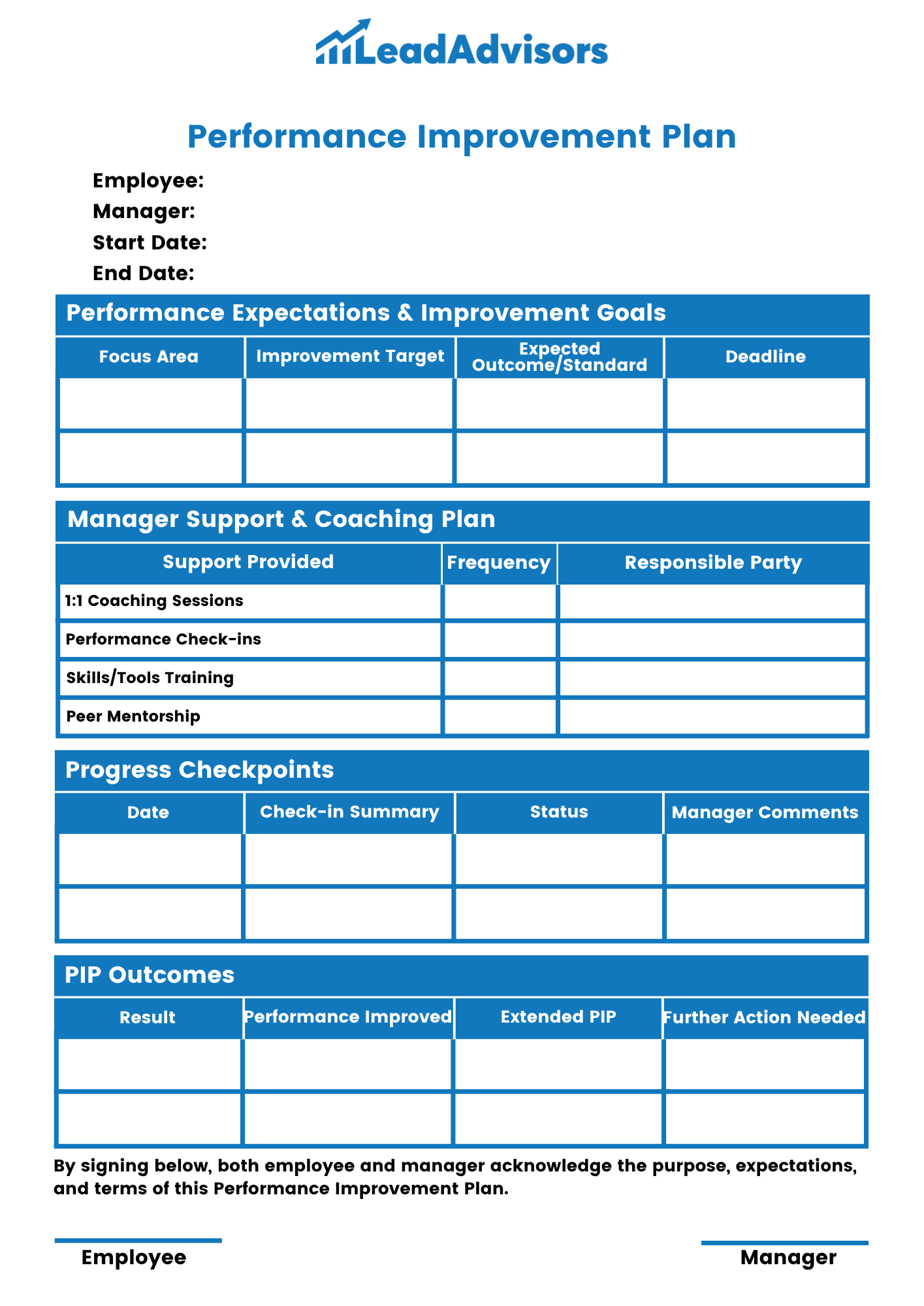
Sometimes performance needs to be addressed clearly and carefully. This template lays out expectations and paths for improvement.
- Use: Formalize underperformance feedback and support.
- Includes: Clear targets, timelines, and coaching plans
- Pros: Transparent and structured, while giving a fair chance to succeed
Use this when it’s time to set boundaries and track progress without surprises.
J. Goal & OKR Templates
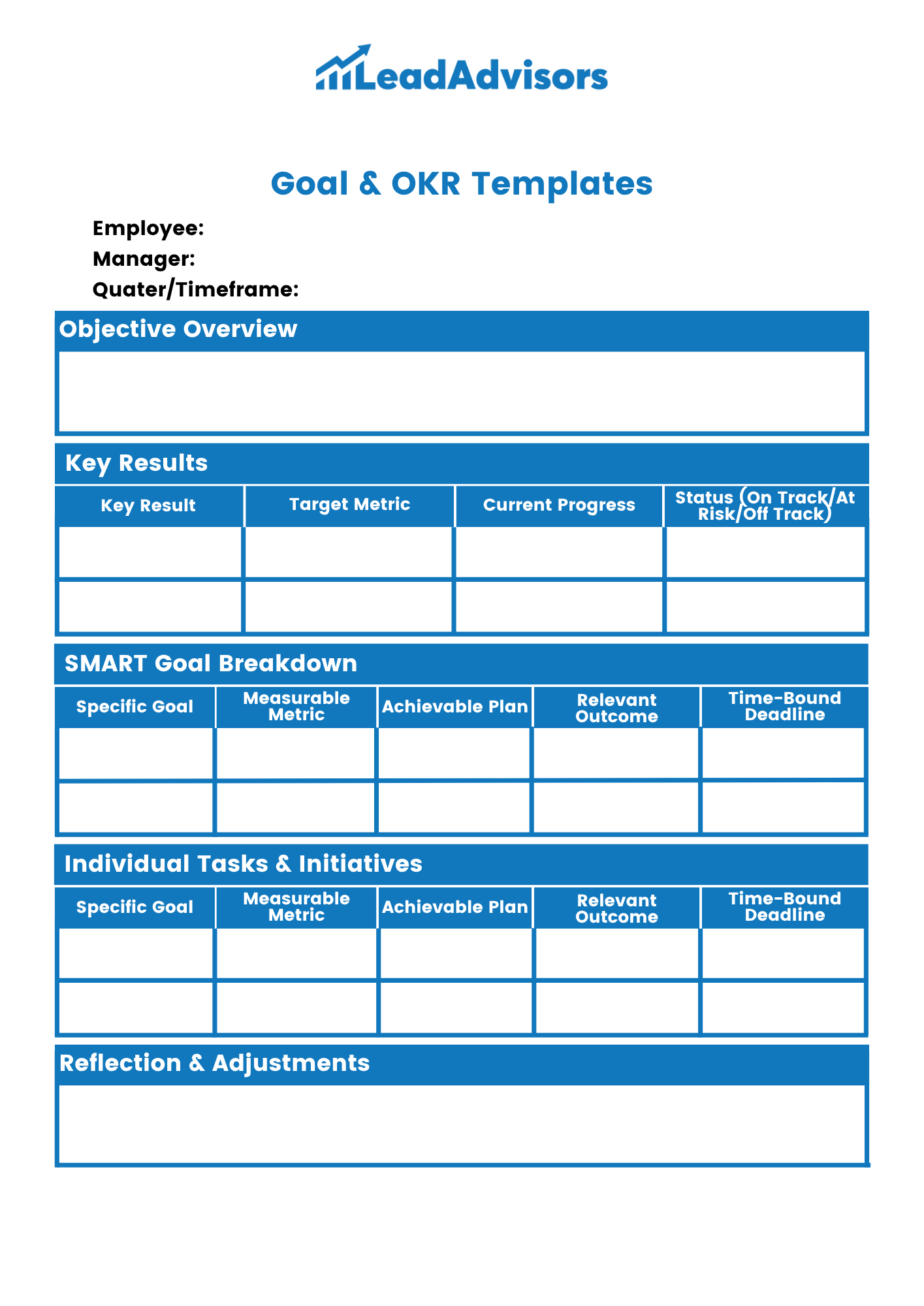
If your team uses goals to steer strategy, this one’s for you.
- Focus: SMART goals, OKRs, and KPIs
- Frameworks: Structured for measurable outcomes
- Best for: Results-driven or remote teams
- Pros: Keeps everyone aligned and focused on impact
I find these templates super helpful for connecting daily tasks to bigger objectives, especially when those tasks support a well-defined customer acquisition strategy.
K. Manager & Upward Feedback Templates
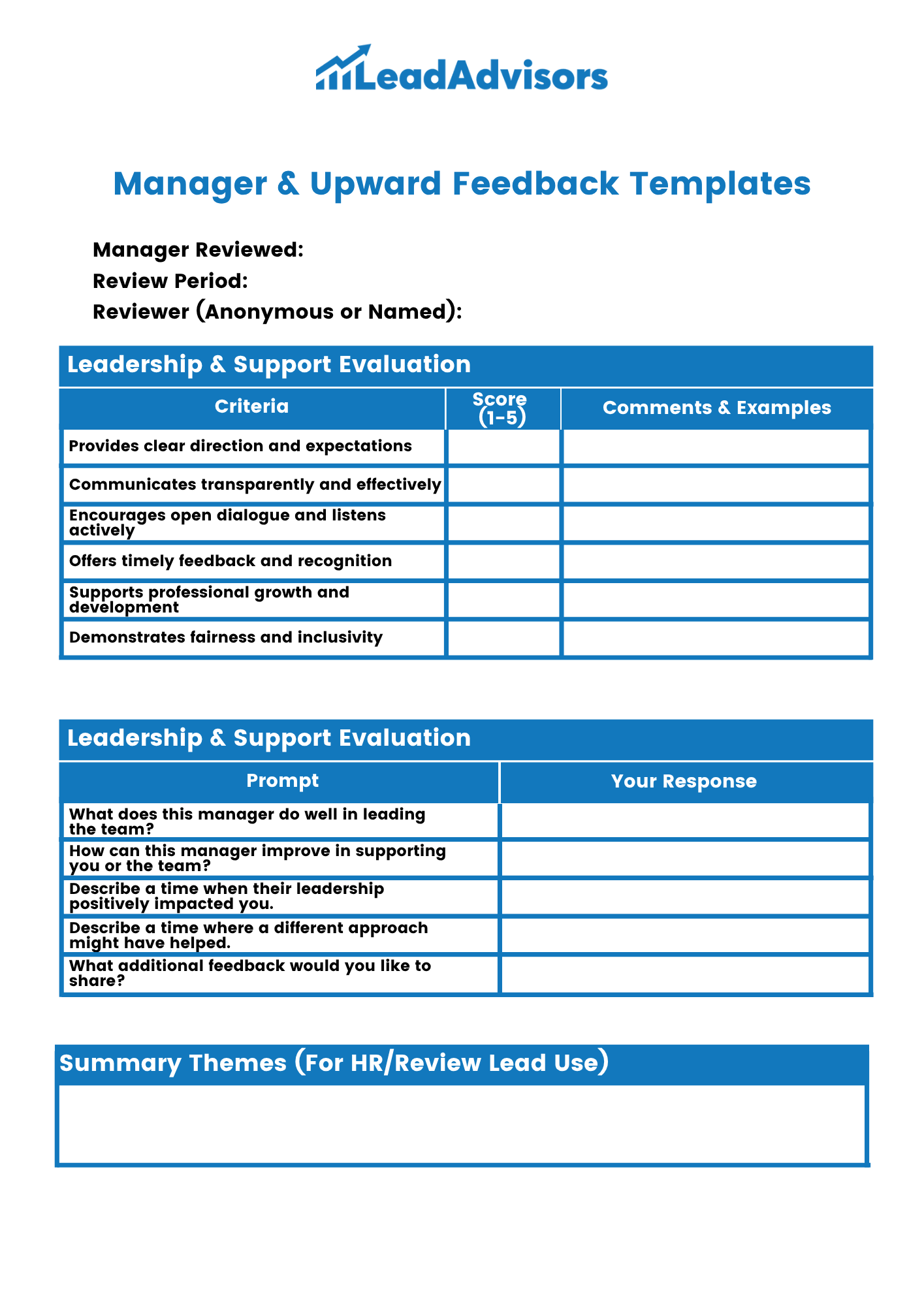
Feedback shouldn’t only go down the org chart. These templates invite peer feedback from team members to evaluate their manager’s support, communication, and leadership.
- Use: Evaluate leadership from the ground up.
- Best for: Team leads and mid-to-senior managers
- Pros: Encourages transparency and leadership growth
It’s also a great way to uncover blind spots in your performance management approach.
L. Team Performance Review Templates
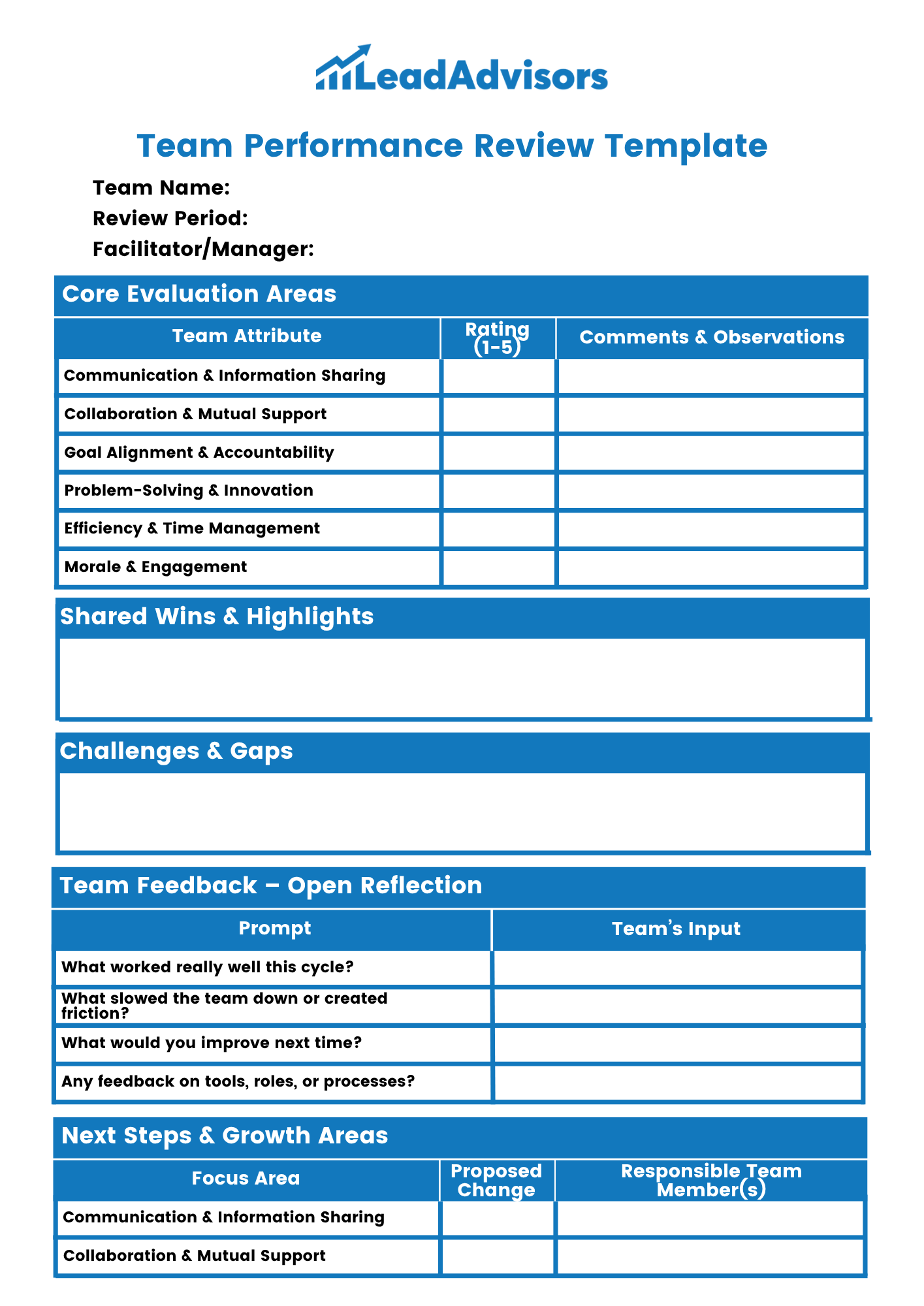
Sometimes the team itself needs an evaluation, not just the individuals on it.
- Purpose: Look at team dynamics, collaboration, and shared outcomes
- Best for: Project-based or agile teams
- Pros: Highlights gaps in team collaboration and celebrates group wins
I like using these at the end of large initiatives or product launches.
M. Behavioral & Core Values Review Templates
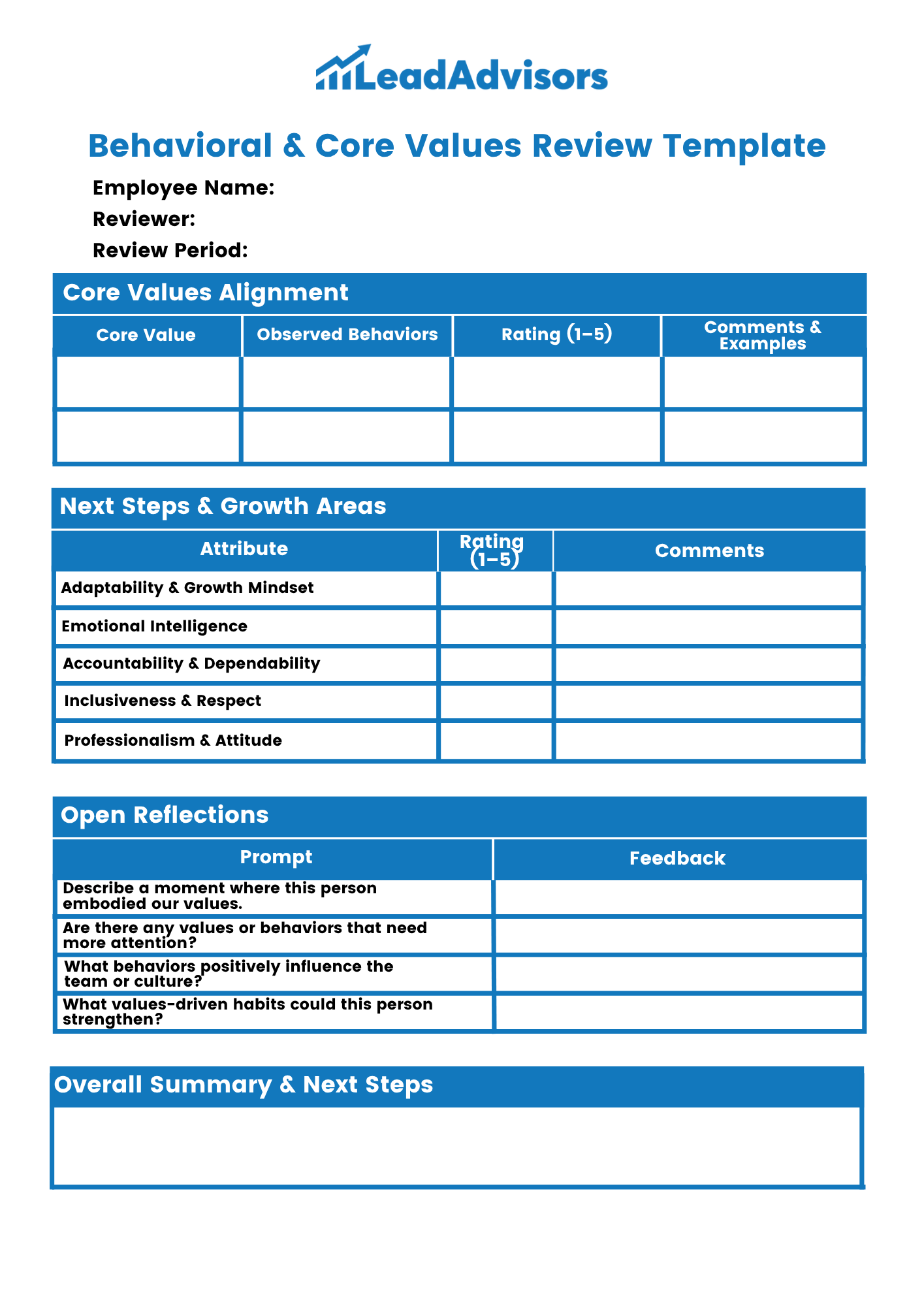
If your company lives and breathes its values, this one’s a must.
- Focus: Culture fit, attitude, workplace behavior
- Best for: Value-first companies or high-growth phases
- Pros: Reinforces soft skills and professional expectations
It’s also great for measuring alignment with core values alongside traditional metrics – just like a brand audit reveals how well your messaging aligns with your mission.
N. Compensation Check-In Templates
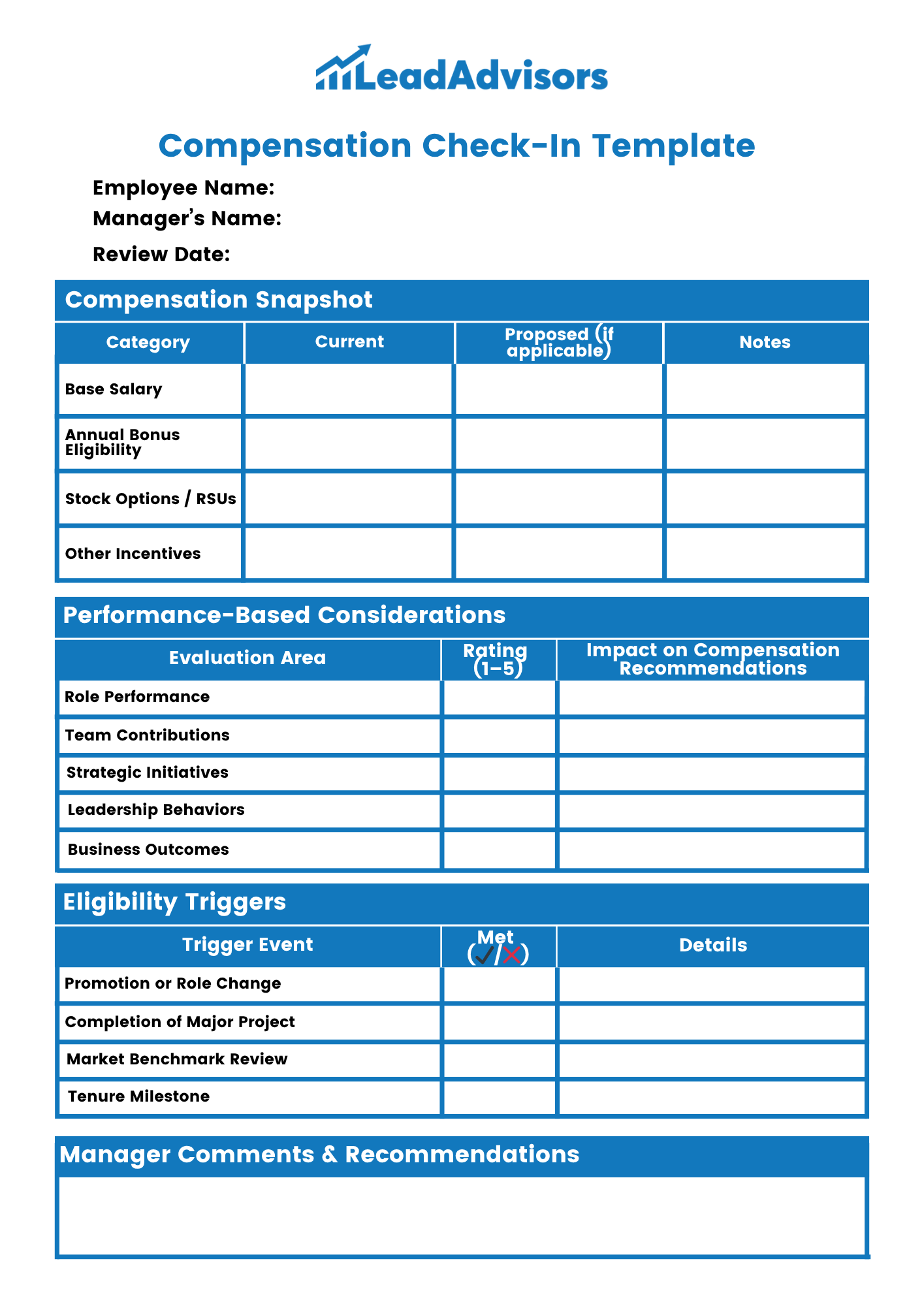
Performance is often tied to pay, so be ready to talk about it.
- Use: Review eligibility for bonuses, salary increases, or stock.
- Best for: Annual merit cycles or role changes
- Pros: Promotes transparency and aligns performance expectations with compensation
Pair it with your performance evaluation form during annual planning cycles.
O. Professional Development Templates
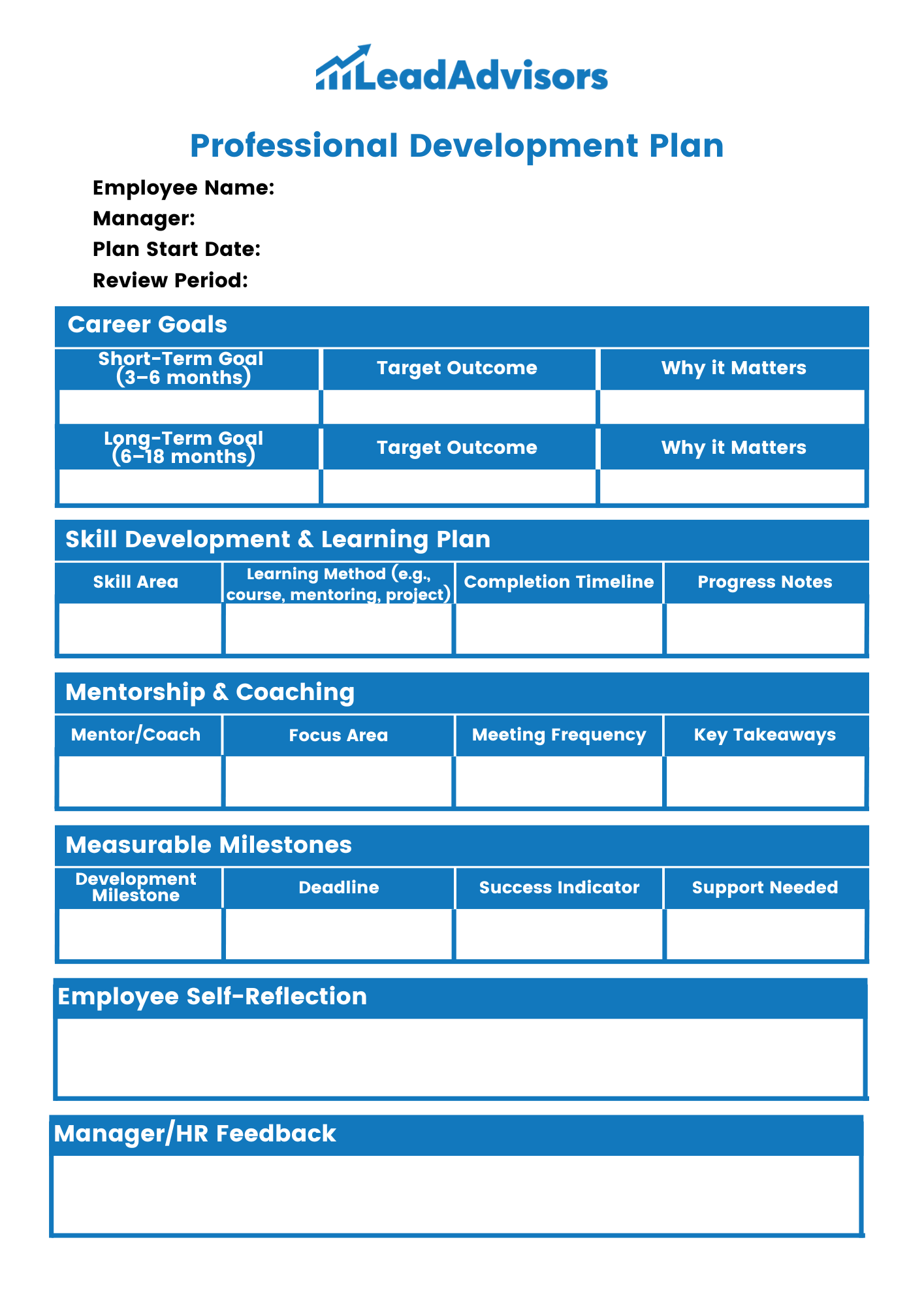
When you’re focused on long-term career development, this template keeps the momentum going.
- Purpose: Plan out upskilling, mentorship, and training
- Includes: Employee development plan, timelines, and support
- Best for: High-potential talent or promotion tracks
- Pros: Builds retention and growth
These are especially valuable for employees eyeing leadership paths.
P. 1-on-1 Progress Check Templates
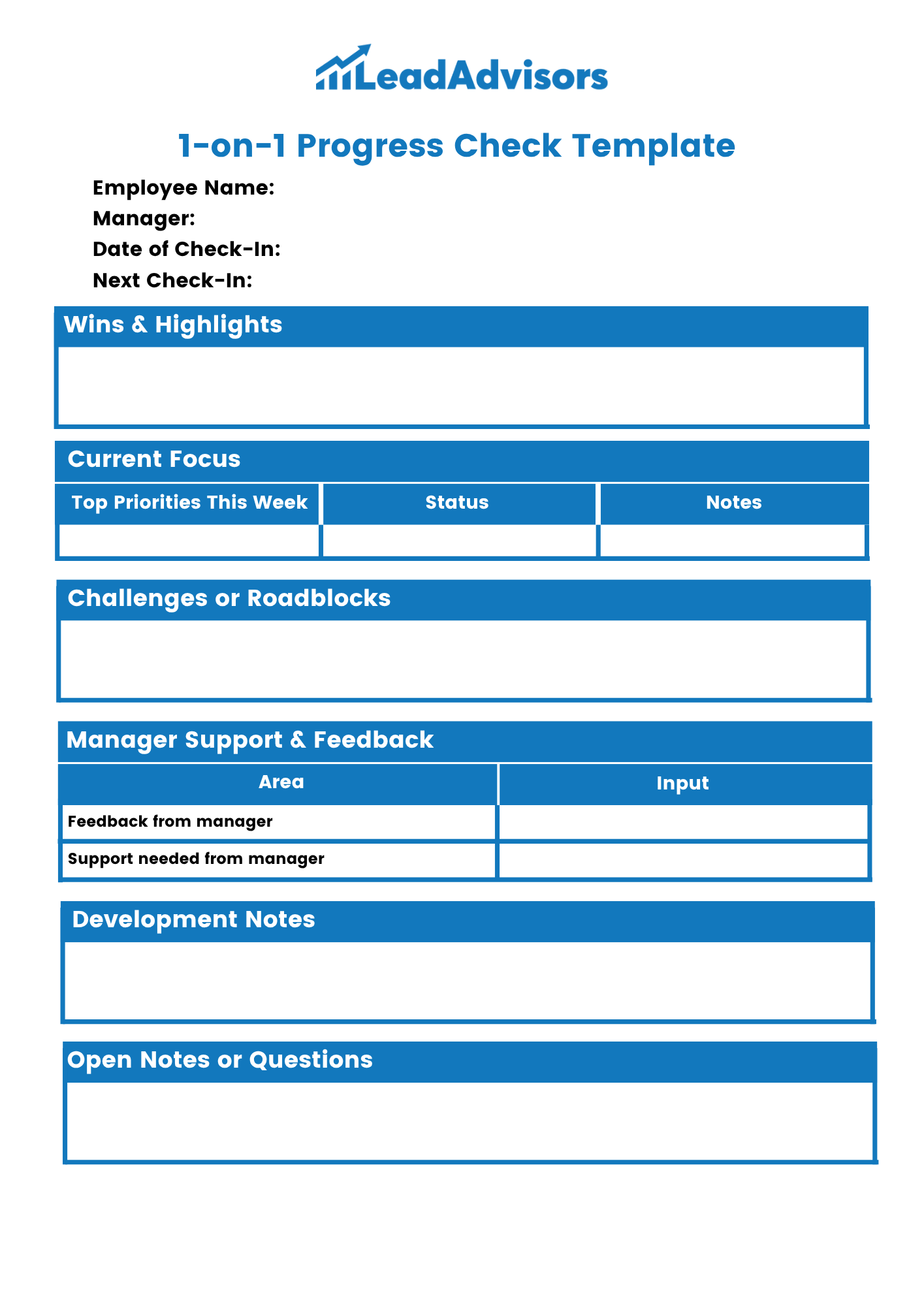
Sometimes you just need something simple to stay on track between major reviews.
- Structure: Quick notes on weekly or biweekly goals
- Best for: Managers and employees staying aligned in real time
- Pros: Prevents miscommunication and supports ongoing development
Great for building a culture of frequent feedback without overwhelming your team.
Every one of these review templates can serve a unique purpose depending on the employee’s role, team structure, and business goals. The key is choosing the right one at the right time – and I’ve got free versions of all of these coming up next.
Digital vs. Manual: Why Software Is Replacing Static Templates
I used to live in Google Docs, Word, and Excel when it came to handling the performance review process. And hey, they got the job done – until they didn’t. Once your team starts growing, those static performance review templates begin to feel clunky fast.
That’s when performance management software steps in – and honestly, I haven’t looked back.
Why Digital Tools Are Winning
Platforms like Quantum, Teamflect, BambooHR, and Plaky offer more than just digitized forms. They simplify your entire employee performance review workflow, much like digital marketing fundamentals streamlined traditional advertising practices.
Here’s what makes them a game-changer:
| Feature | What It Does |
| Automated Review Cycles | No more chasing down files. These tools automate scheduling, reminders, and review period timelines. |
| Multi-Rater Feedback | Analyse insights from peers, managers, and direct reports with built-in 360-degree feedback and peer review tools. |
| Goal Alignment & Tracking | Link individual employee goals to team or organizational goals, so performance is measured by impact, not just effort. |
| Real-Time Analytics | Instantly access dashboards, trend data, and rating summaries – no more manual math. Supports smarter employee development and engagement. |
| Better Documentation | Store every performance evaluation, self-assessment, and comment in one place for easy reference and long-term professional development. |
When to Upgrade From Templates to Software
Still using Word or Excel for performance reviews? That’s totally fine if you’re managing a small team or running a few annual performance reviews. But here’s when I recommend making the switch:
- You’re juggling reviews across multiple departments or locations
- You must support new team members, provide direct reports, and provide cross-functional feedback.
- You want to standardize your employee review process without drowning in email threads.
- You’re scaling your performance management strategy and need real-time insight.
- You’re ready for more than checkboxes – you want actionable feedback, better visibility, and smarter workflows.
In short, digital performance software doesn’t just upgrade your forms – it transforms your whole evaluation process. If you’re looking to go from reactive to proactive with your reviews, it’s definitely worth considering.
Frequently Asked Questions
How often should performance review templates be updated?
Can performance review templates be used for remote teams?
How do I introduce a new performance review template to my team?
What’s the best way to ensure performance reviews are bias-free?
Are there legal considerations when using performance review forms?
Conclusion
If there’s one thing I’ve learned over the years, it’s that a good performance review template can make or break your entire performance management strategy.
Templates bring consistency, structure, and clarity to a process that – let’s be honest – can sometimes feel awkward or rushed. They help ensure that every employee’s performance is evaluated fairly and thoughtfully, with space for both constructive feedback and real growth.
But here’s the key: use templates strategically, not just procedurally.
Don’t just check boxes and move on. Use these templates to fuel meaningful conversations, align on future goals, and support employee development in a real way – just like an inbound marketing strategy focuses on long-term value rather than one-off interactions.
Because in 2025, performance reviews shouldn’t be something we dread – they should be something that drives us (and our teams) forward.



